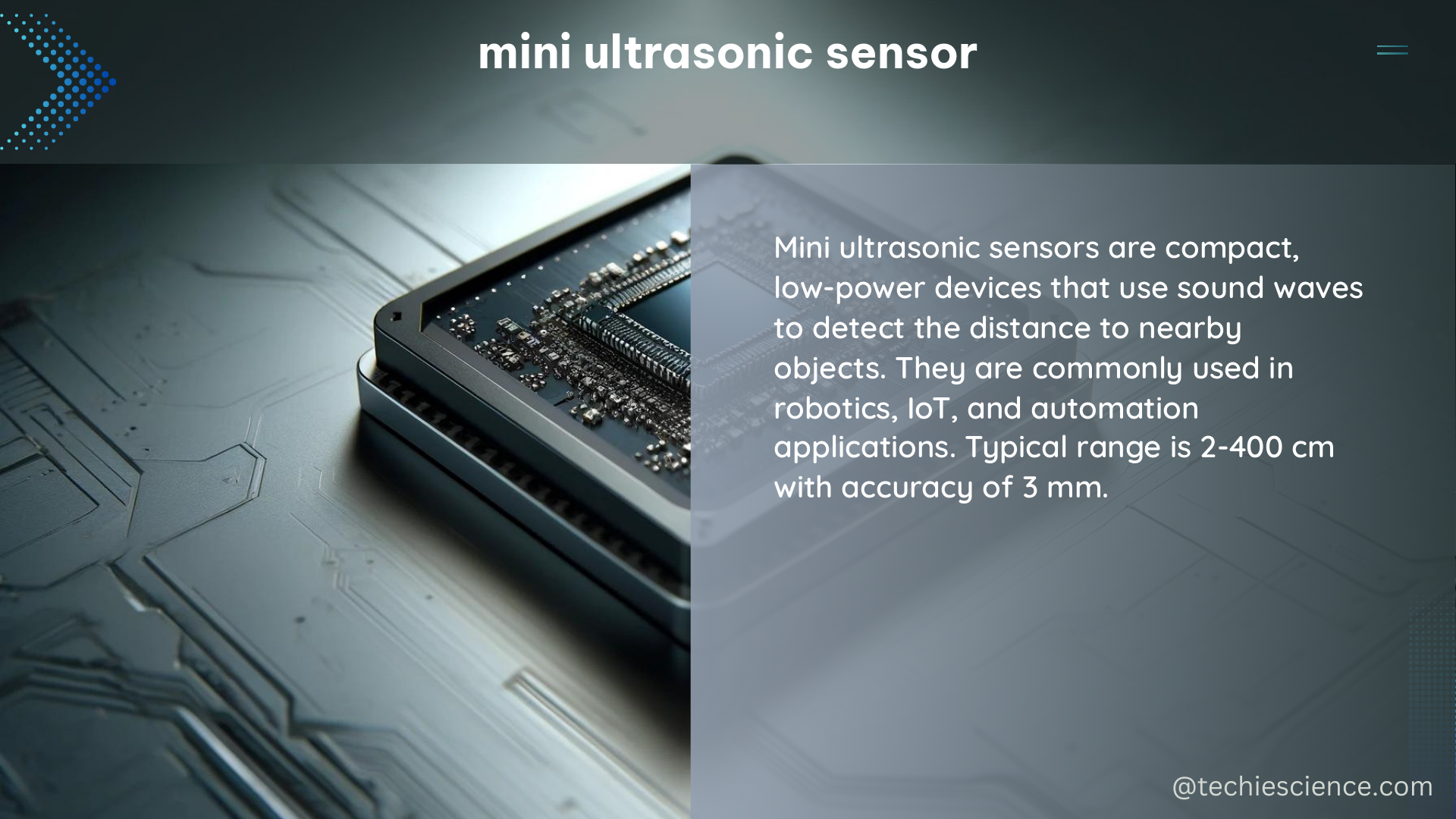The mini ultrasonic sensor is a compact, versatile device that utilizes sound waves to measure distance or detect objects within its range. These sensors are widely used in various applications, including robotics, automation, and industrial automation, due to their precise distance measurement capabilities and compact size.
Understanding the Technical Specifications of Mini Ultrasonic Sensors
When it comes to mini ultrasonic sensors, there are several key technical specifications that you need to be aware of:
1. Range
The range of a mini ultrasonic sensor refers to the maximum and minimum distance that the sensor can measure. This is typically specified in centimeters or inches. For example, the popular HC-SR04 mini ultrasonic sensor has a range of 2 cm to 400 cm.
2. Resolution
The resolution of a mini ultrasonic sensor is the smallest change in distance that the sensor can detect. This is usually specified in millimeters or microns. The MaxBotix LV-MaxSonar-EZ4 sensor, for instance, has a resolution of 1 mm.
3. Frequency
The frequency of the ultrasonic waves emitted by the sensor is another important specification, typically measured in kilohertz (kHz). The HC-SR04 sensor, for example, operates at a frequency of 40 kHz.
4. Angular Field of View
The angular field of view of a mini ultrasonic sensor refers to the angle at which the sensor can detect objects. This is usually specified in degrees. The MaxBotix LV-MaxSonar-EZ4 sensor has an angular field of view of 50 degrees.
5. Output Signal
The type of signal that the mini ultrasonic sensor provides is also a crucial specification. Common output signals include analog voltage and pulse width modulation (PWM). The HC-SR04 sensor, for instance, provides a PWM output signal.
6. Power Supply
The voltage and current requirements of the mini ultrasonic sensor are essential to consider when designing a system. The HC-SR04 sensor, for example, requires a 5V power supply.
7. Operating Temperature
The temperature range in which the mini ultrasonic sensor can operate is another important specification. The MaxBotix LV-MaxSonar-EZ4 sensor can operate from -40°C to +85°C.
In addition to these technical specifications, it’s crucial to consider the sensor’s accuracy and precision, which are often specified as a percentage of the full-scale output or a fraction of the reading. For example, a sensor with an accuracy of ±1% of the full-scale output means that the actual measurement could be up to 1% higher or lower than the sensor’s reading.
Hands-On with Mini Ultrasonic Sensors: A DIY Distance-Measuring Device

To illustrate the practical application of mini ultrasonic sensors, let’s explore a DIY project: building a distance-measuring device using an Arduino microcontroller and an HC-SR04 ultrasonic sensor.
Hardware Setup
- Connect the HC-SR04 sensor to the Arduino board:
- Connect the VCC pin of the sensor to the 5V pin on the Arduino.
- Connect the GND pin of the sensor to the GND pin on the Arduino.
- Connect the TRIG pin of the sensor to a digital pin on the Arduino (e.g., pin 9).
- Connect the ECHO pin of the sensor to another digital pin on the Arduino (e.g., pin 10).
Software Implementation
- Write an Arduino sketch that reads the sensor’s output signal and calculates the distance to the object:
- Use the
pulseIn()function to measure the time it takes for the ultrasonic wave to travel to the object and back. - Calculate the distance based on the time of flight and the speed of sound (approximately 343 m/s).
- Display the distance on an LCD screen or send it to a computer via a serial connection.
Here’s a sample Arduino sketch that demonstrates the basic functionality:
// Define the pins for the HC-SR04 sensor
const int trigPin = 9;
const int echoPin = 10;
// Define variables to store the distance
long duration;
int distance;
void setup() {
// Initialize the serial communication
Serial.begin(9600);
// Set the trigger and echo pins as input/output
pinMode(trigPin, OUTPUT);
pinMode(echoPin, INPUT);
}
void loop() {
// Clear the trigger pin
digitalWrite(trigPin, LOW);
delayMicroseconds(2);
// Send a pulse to the trigger pin
digitalWrite(trigPin, HIGH);
delayMicroseconds(10);
digitalWrite(trigPin, LOW);
// Measure the duration of the echo pulse
duration = pulseIn(echoPin, HIGH);
// Calculate the distance in centimeters
distance = duration * 0.034 / 2;
// Print the distance to the serial monitor
Serial.print("Distance: ");
Serial.print(distance);
Serial.println(" cm");
delay(100);
}
This sketch demonstrates the basic functionality of the HC-SR04 ultrasonic sensor, including sending a trigger pulse, measuring the echo pulse duration, and calculating the distance to the object. You can further enhance the project by adding features such as object detection, collision avoidance, or integration with other components like motors or servos.
Conclusion
Mini ultrasonic sensors are powerful tools for distance measurement and object detection, with a wide range of applications in robotics, automation, and industrial settings. By understanding the technical specifications of these sensors, including range, resolution, frequency, angular field of view, output signal, power supply, and operating temperature, you can design and implement effective systems that leverage the capabilities of these compact and versatile devices.
References
- AIHA. (2018). The Future of Sensors. Retrieved from https://aiha-assets.sfo2.digitaloceanspaces.com/AIHA/resources/Get-Involved/AIHA_Future-of-Sensors_web_updated.pdf
- OLLINTEC. (2016). Sensor Technology Handbook. Retrieved from http://ollintec.com/fie/sensores/libros/Sensor%20Technology%20Handbook.pdf
- ADS-51-HDBK. (1996). Sensor Fusion. Retrieved from https://www.avmc.army.mil/Portals/51/Documents/TechData%20PDF/ADS51HDBK.pdf
- NASA. (2024). NASA Spinoff 2024. Retrieved from https://spinoff.nasa.gov/sites/default/files/2024-01/NASA.Spinoff_2024_508.pdf

The lambdageeks.com Core SME Team is a group of experienced subject matter experts from diverse scientific and technical fields including Physics, Chemistry, Technology,Electronics & Electrical Engineering, Automotive, Mechanical Engineering. Our team collaborates to create high-quality, well-researched articles on a wide range of science and technology topics for the lambdageeks.com website.
All Our Senior SME are having more than 7 Years of experience in the respective fields . They are either Working Industry Professionals or assocaited With different Universities. Refer Our Authors Page to get to know About our Core SMEs.